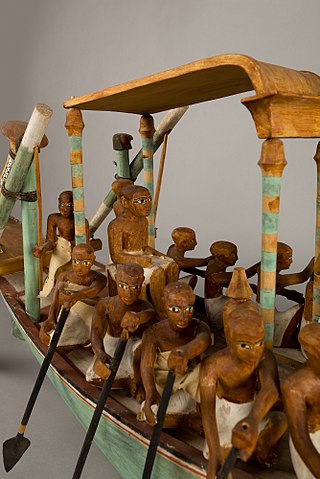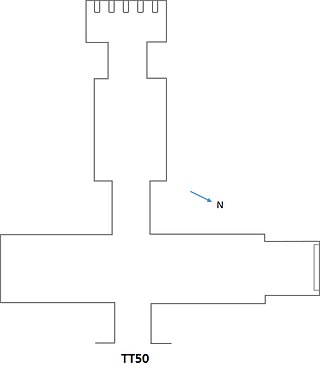Related Research Articles

The necropolis of Sheikh Abd el-Qurna is located on the West Bank at Thebes in Upper Egypt. It is part of the archaeological area of Deir el-Bahari, and named after the domed tomb of the local saint. This is the most frequently visited cemetery on the Theban west bank, with the largest concentration of private tombs.

Hapuseneb was the High Priest of Amun during the reign of Hatshepsut.
Nebetia was an ancient Egyptian princess of the 18th Dynasty. She was the granddaughter of Pharaoh Thutmose IV and the daughter of Prince Siatum. She is one of the few examples of a pharaoh's granddaughter bearing the title of King's Daughter – the ancient Egyptian equivalent of "princess" – which normally belonged only to women whose fathers actually ruled.

Alexander Henry Rhind was a Scottish antiquarian and archaeologist.

The ancient Egyptian noble Intefiqer(ỉnỉ-ỉt.f ỉqr) was overseer of the city and Vizier under Amenemhet I and Senusret I during the early 12th Dynasty. He is known from several rock inscriptions in Lower Nubia, showing that he was part of a military mission into this region. He appears in an inscription found at the Red Sea coast and in the so-called Reisner Papyrus. Two rock inscriptions in Lower Nubia mention him. They seem to indicate that he was involved in a military campaign into this region. The inscriptions are not dated, but other inscriptions in the region seem to indicate a military campaign in year 29 of Amenemhet I, which corresponds to the 9th year of Senusret I. Intefiqer is also known from a stela found at Wadi el-Hudi, dated to year 20. It reports the bringing of amethyst.

The Theban Tomb TT99 is located in Sheikh Abd el-Qurna. It forms part of the Theban Necropolis, situated on the west bank of the Nile opposite Luxor. The sepulchre is the burial place of the ancient Egyptian noble, Senneferi. It has been worked on by an expedition from the University of Cambridge since 1992.

The ancient Egyptian official Meketre was chancellor and high steward during the reign of Mentuhotep II, Mentuhotep III and perhaps Amenemhat I, during the Middle Kingdom.

Tiaa was an Ancient Egyptian princess of the 18th Dynasty. She was the daughter of Pharaoh Thutmose IV, she was named after her paternal grandmother Tiaa.
Amenemopet was an ancient Egyptian princess during the 18th Dynasty, probably a daughter of Thutmose IV.
Sennefer or Senneferi was an ancient Egyptian official during the 18th Dynasty.
Pyhia or Pyihia or Petepihu was an Ancient Egyptian princess during the 18th Dynasty, a daughter of Thutmose IV.

The Theban Tomb TT67 is located in Sheikh Abd el-Qurna. It forms part of the Theban Necropolis, situated on the west bank of the Nile opposite Luxor. The tomb is the burial place of the ancient Egyptian official Hapuseneb, who was High Priest of Amun during the New Kingdom reign of Hatshepsut.

Khay (Kh-'-y) was an Ancient Egyptian noble who served as Vizier in the latter part of the reign of Ramesses II, during the 19th Dynasty.
The Theban Tomb TT23 is located in Sheikh Abd el-Qurna, part of the Theban Necropolis, on the west bank of the Nile, opposite to Luxor. It is the burial place of the ancient Egyptian official, Tjay or Thay called To, who was a royal scribe of the dispatches of the Lord of the Two Lands, during the 19th Dynasty. Thay served during the reign of Merenptah.

The Theban Tomb TT58 is located in Sheikh Abd el-Qurna, part of the Theban Necropolis, on the west bank of the Nile, opposite to Luxor. The tomb was originally carved for a courtier dating to the time of Amenhotep III and later usurped during the Ramesside period.

The Theban Tomb TT111 is located in Sheikh Abd el-Qurna, part of the Theban Necropolis, on the west bank of the Nile, opposite to Luxor. The tomb belongs to a 19th Dynasty ancient Egyptian named Amenwahsu, who was a Scribe of divine writing of the estate of Amun during the reign of Ramesses II. Amenwahsu was a son of Simut, who was a head of outline draughtsmen, and the lady Wiay. Amenwhasu's wife was named Iuy. She was a songstress of Bubastis.
The Theban Tomb TT170 is located in Sheikh Abd el-Qurna, part of the Theban Necropolis, on the west bank of the Nile, opposite to Luxor. It is the burial place of the ancient Egyptian Nebmehyt, who was a scribe of recruits of the Ramesseum in the Estate of Amun during the reign of Ramesses II in the Nineteenth Dynasty.

The Theban Tomb TT171 is located in Sheikh Abd el-Qurna, part of the Theban Necropolis, on the west bank of the Nile, opposite to Luxor. The name of the owner is not known. His wife was named Isis (Aset) according to an inscription on the facade. The tomb dates to the Eighteenth Dynasty of Egypt.

The Theban Tomb TT50 is located in Sheikh Abd el-Qurna, part of the Theban Necropolis, on the west bank of the Nile, opposite to Luxor. It is the burial place of the ancient Egyptian official Neferhotep, who was a Divine father of Amun-re during the reign of Horemheb of the 18th Dynasty.

The Theban Tomb TT120 is located in Sheikh Abd el-Qurna. It forms part of the Theban Necropolis, situated on the west bank of the Nile opposite Luxor. The tomb is the burial place of the ancient Egyptian official Ahmose, who was the second prophet of Amun-Ra at Karnak and later the first prophet of Amun at Henqet-Ankh, the mortuary temple of Tuthmosis III at Qurnah during the reign of the Tuthmosis III.